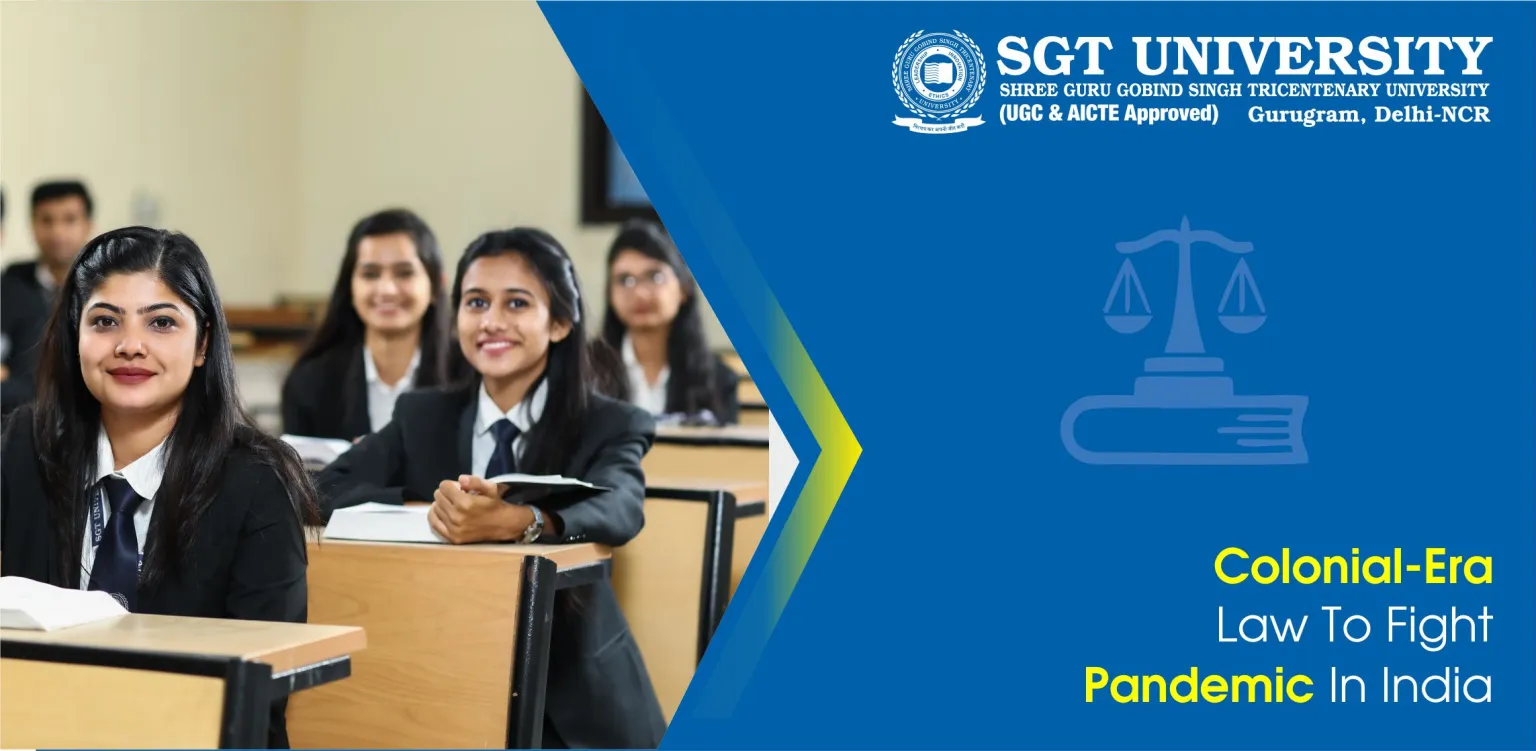The Epidemic Diseases Act, 1897 is a law that was first created to tackle “bubonic plague” in Mumbai which was formerly known as ‘Bombay’. The law is meant to curb down the spread of this horrendous epidemics by extending special powers that are required for the implementation of containment measures to control the spread of the disease.
Since then the Act has been regularly used to contain various diseases in India such as swine flu, cholera, malaria, and dengue. In 2018, the Act was enforced as cholera began to spread in a region of Gujarat. In 2015, it was used to deal with dengue and malaria in Chandigarh, and in 2009 it was invoked in Pune to combat swine flu. Starting in March 2020, the act is being enforced across India in order to limit the spread of coronavirus disease in 2019.
LOOPHOLES OF THE ACT
The Act does not provide any power to the Centre to intervene in biological emergencies. It has to be substituted with an Act that takes care of the prevailing and foreseeable public health needs, including emergencies such as BT (bioterrorism) attack and use of biological weapons by an adversary, cross border issues, and international spread of diseases,”.
Behind the urgency to detect and quarantine suspected Covid-19 patients and the blaring call for social distancing lies a stark reality: in terms of enforcing laws to contain Covid-19, the Centre can do little on the ground. The legal inadequacy to tackle disease outbreaks was known for long, baby steps were taken, but at the end of the day, the country was not ready when it encountered another pandemic — arguably the severest since the 1918 influenza pandemic that killed around seven million people in the country. The main legal weapon the government possesses today is the Epidemic Disease Act of 1897, a hurriedly drafted short legislation to stonewall the bubonic plague that devastated life in Bombay in 1896, forcing people to migrate out of the city. Health is a state subject. Union government’s role could, at best, be advisory and coordinating in nature, since Section 2 of the Act only empowers a state to inspect people and segregate suspected patients. The only power the Centre derives from the British Raj-era law is on “inspection of any ship or vessel leaving or arriving at any port” that comes under its jurisdiction. The Act does not even mention airports. It is understandable — there were no airplanes 123 years ago. However, when the Centre drafted the 156-page Management of Biological Disaster Guideline in 2008 — followed in letter and spirit even today — the realization came that the Epidemic Disease Act was inadequate to deal with bioterrorism and international spread of diseases.
After all, the law does not bestow the Centre any power beyond issuing advisories and coordinating. It cannot even regulate the transfer of biological samples — imagine a coronavirus sample getting stolen while being taken to a laboratory.
During the first term of the UPA government, a public health emergency bill was drafted. But the bill went into cold storage after states called it an infringement upon their powers.
Later, during the Modi government’s first term, a similar draft was more sincerely followed up, with the health & family welfare ministry naming it Public Health (Prevention, Control, and Management of Epidemics, Bio-terrorism, and Disasters) Bill 2017, proposing to repeal the epidemic law of 1897. The draft bill explains in clearer terms the quarantining of suspects and isolation of the infected, in addition to empowering the Centre to direct states and district or local bodies as well as usurping powers bestowed to states under Section 3 if it is found to be “expedient and in public interests” to do so. In addition, the proposed law also embedded a provision marking that anyone intentionally violating the law could end up paying a fine of up to `1 lakh and face imprisonment of up to two years.
This provision could have been useful now given the rising instances of Covid-19 suspects skipping quarantine. Under current laws, police can charge someone under IPC’s Section 269 for negligent act and Section 270 for the malignant act for spreading an infectious disease that is dangerous to life.
Health Ministry concedes that there is a need to strengthen India’s legal framework but laws alone are insufficient. The problem arises mainly because of coordination and implementation issues. The home ministry, which usually takes the lead during crises such as earthquakes, floods, and cyclones, has taken a backseat, allowing the health ministry to coordinate with states as mandated by the Disaster Management Act of 2005.
FURTHERMORE ON EPIDEMIC ACT OF 1897
The seventh schedule lists health as a state subject, and different states have provisions that aren’t necessarily uniform and harmonized.
In the context of the Wuhan virus, the ministry of health and family welfare (MoHFW) suggested that states/UTs invoke Section 2 of the Epidemic Diseases Act of 1897, and many states/UTs have done so. The third plague epidemic also originated in China, though in Yunnan, not Wuhan. It, too, was imported, through port cities like Mumbai (spreading to Pune), Kolkata, and Karachi. The upshot was the Plague Commission, which identified September 23, 1896, as the first official outbreak of the plague, and delivered a mammoth five-volume report.
Majorly four questions were asked in this report-
- How did the plague originate in different parts of India?
- How was the disease communicated?
- What were the effects of the curative serum?
- What were the effects of preventive inoculation and how many people died as a result of the plague?
Now, these were surely not easy questions to answer, as it depended on timelines and region. On all India basis, Plague Commission computed mortality as 0.5 per 1,000 per year. But that is for three years- 1896 to 1898. With an extended timeline(the plague lingered), estimates of Indian Mortality figures range from 2 million to 10 million.
The plague led to the Epidemic Diseases Act, enacted on February 4, 1897. And sadly once the legislation is passed, we rarely read the statement of objects and reasons. In this case, the statement of objects and reasons said, “The object of the Bill is sufficiently explained by the title thereof and the spread of the bubonic plague from Bombay, unfortunately, renders it unnecessary to dwell on the reasons for its introduction in Council. It may however be stated that its main provisions are based upon those contained in Sections 4.34 and 47.1 of the City of Bombay Municipal Act, 1888.” Right after this special power was conferred on local authorities, and were implemented with the oppressive force for example, in Bombay and Pune. a Plague Committee was established in March 1897 by Bombay Presidency and WC Rand was made the Chairman.
The Epidemic Diseases Act is very perfunctory. With only four sections, out of which one is the title. Section 2 confers special powers on the government, which are over and above its normal powers. One needs to understand that no statute is constant over time.
And this legislation from 1897 is no different. It was amended in 1914, 1920, and 1956. Nonetheless, on reading it you will realize it is vintage. For example, in Section 2(2)(b), the state government can take measures and prescribe regulations for “the inspection of persons traveling by railway or otherwise, and the segregation, in hospital, temporary accommodation or otherwise, of persons suspected by the inspecting officer of being infected with any such disease”. Similarly, under Section 2A, “When the Central Government is satisfied that India or any part thereof is visited by, or threatened with, an outbreak of any dangerous epidemic disease and that the ordinary provisions of the law for the time being in force are insufficient to prevent the outbreak of such disease or the spread thereof, the Central Government may take measures and prescribe regulations for the inspection of any ship or vessel leaving or arriving at any port in [the territories to which this Act extends] and for such detention thereof, or of any person intending to sail therein, or arriving thereby, as may be necessary.”Railways, and ships, and ports, and what about airlines and airports? Of course, an Act as old as 123years was not capable of foreseeing airplanes at that time. Along with this, there used to be a Section 2B that allowed state governments to requisition private vehicles in times of plague, but that has also been repealed.
It’s very essential for us to understand that a statute just doesn’t become dysfunctional simply because it is old, but it does become dysfunctional when it is overtaken by events. Among other things, when it has been overtaken by the Constitution. “The seventh schedule lists health as a state subject, and different states have provisions that aren’t necessarily uniform and harmonized. Some have amended the Epidemic Diseases Act; some have their own public health laws. (Tamil Nadu was the first, in 1939).”
With regard to Public Health, Kerala has two separate public health Acts—one for Travancore-Cochin, and the second for Malabar. Initially, there were plans to unify the two, but nothing happened till date on those lines. Today, health issues are very different, and broader too in comparison to what we had in 1897. The role of the private sector is different from what it was then. In 2017, MoHFW prepared a bill known as “The Public Health (Prevention, Control, and Management of Epidemics, Bio-terrorism, and Disasters) Bill”. This is still a draft. The world has moved beyond epidemic diseases. The Epidemic Diseases Act has four sections, this draft bill has fourteen, with 14(1) being probably the most important. This says, “The Epidemic Diseases Act, 1897 is hereby repealed.” Incidentally, the 1897 legislation doesn’t define “epidemic”. Admittedly, the word is difficult to pin down. But, the bill makes an attempt, saying, “Epidemic means the occurrence in a community or region of cases of an illness, specific health-related behavior, or other health-related events clearly in excess of normal expectancy”. However, it is still a bill.


